Science Olympiad Model Test Paper - 3 | Science Olympiad Class 7 PDF Download
Note: The questions provided in this document are similar to the questions that were asked in the actual Olympiad exam. So, we recommend you study these for your Olympiad preparation.
Logical Reasoning Section
Q1: Ahika is positioned to the North of Sumit. Priyanka is located to the East of Ahika. Puneet is situated to the West of Sumit. What direction is Puneet in relation to Priyanka?(a) West
(b) South-West
(c) South
(d) North-East
 View Answer
View Answer 
Ans: (b)
- Understanding positions: Ahika is North of Sumit, meaning if you face North, Ahika is directly in front of you.
- Priyanka's position: Since Priyanka is East of Ahika, she is to the right when facing North.
- Puneet's position: Puneet is West of Sumit, which places him to the left when facing North.
- Finding Puneet's position relative to Priyanka: If you visualize this, Puneet is to the South-West of Priyanka.
Q2: Complete the following series:
FIL, GJM, HKN, ___
(a) ILM
(b) IJO
(c) ILN
(d) ILO
 View Answer
View Answer 
Ans: (d)
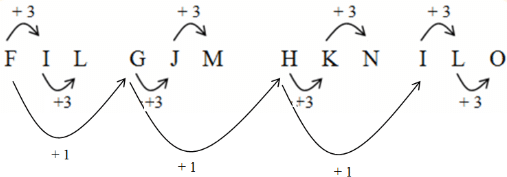
The patter is: + 3, + 3, + 3
The series is running according to the alphabetical order -
F + 3 = I
I + 3 = L
Then, the next letter to F is G.
G + 3 = J
J + 3 = M
= GJM
Then, the next letter to G is H.
H + 3 = K
K + 3 = N
= HKN
Then, the next letter to H is I.
So,
I + 3 = L
L + 3 = O
= ILO
Q3: Directions: In the following question, there is a relationship between the two terms to the left of : : and the same relationship exists between the two terms to its right, out of which one term is missing. Choose the missing term from the given options.
HORSE : STABLE :: RABBIT : ?
(a) Burrows
(b) Shed
(c) Hole
(d) Den
 View Answer
View Answer 
Ans: (a)
- A horse lives in a stable.
- Rabbits live in burrows.
So here, the horse is to stable as rabbit is to burrows.
Q4: If in a certain language, COMPETITION is CODED as BNLODSHSHNM, then how will DISCONTINUED be written in that code?
(a) CHRBNMHSMTDC
(b) CHRBNMSHMTDC
(c) CHRBMNSHMTDC
(d) CRHBNMSHMTDC
 View Answer
View Answer 
Ans: (b)
Q5: If 'S' represents '÷', 'T' represents '×', 'U' represents '+' and 'V' represents '–', what is the result of 16 U 12 S 4 T 9 V 3?
(a) 36
(b) 38
(c) 40
(d) 42
 View Answer
View Answer 
Ans: (c)
- First, replace the symbols with their respective operations: 16 + 12 ÷ 4 × 9 - 3.
- Next, follow the order of operations (BODMAS/BIDMAS): Start with division and multiplication from left to right.
- Calculate 12 ÷ 4 = 3, then 3 × 9 = 27.
- Now, the expression is 16 + 27 - 3. Perform addition and subtraction from left to right.
- So, 16 + 27 = 43, and then 43 - 3 = 40.
Thus, the final answer is 40.
Q6: Select the odd one out.
(a) 12
(b) 23
(c) 50
(d) 67
 View Answer
View Answer 
Ans: (d)
- The question asks to identify the odd one out among the numbers provided.
- Looking at the numbers, 12, 23, and 50 are all even numbers, while 67 is an odd number.
- Thus, 67 does not fit with the others, making it the odd one out.
- Therefore, the correct answer is (d).
Q7: Find out the alternative figure which contains figure (X) as its part.

(a) (1)
(b) (2)
(c) (3)
(d) (4)
 View Answer
View Answer 
Ans: (b)
Q8: Choose the appropriate option which resembles the perfect mirror image of the following figure:

(a) 
(b) 
(c) 
(d) 
 View Answer
View Answer 
Ans: (d)
Figure in the question contains some numbers.
We have to find the mirror image of the given figure.
To find the mirror image, flip it horizontally.
The mirror image will be the same as shown in option D.
Q9: How many pairs of letters can be found in the word MATHEMATICS, where the number of letters between them matches their distance in the English alphabet?
(a) Three
(b) Four
(c) Two
(d) One
 View Answer
View Answer 
Ans: (c)
- To solve this, we need to look for pairs of letters in "MATHEMATICS" that have the same number of letters between them as their position in the English alphabet.
- For example, the letters 'M' and 'A' are 12 letters apart in the alphabet, and they have 11 letters between them in the word.
- After checking all possible pairs, we find that there are two pairs that meet this criterion.
- Thus, the correct answer is (c) Two.
Q10: In the following question, find out the alternative which will replace the question mark.
NATION : ANTINO :: HUNGRY : ?
(a) HNUGRY
(b) UHNGYR
(c) YRNGUH
(d) UNHGYR
 View Answer
View Answer 
Ans: (b)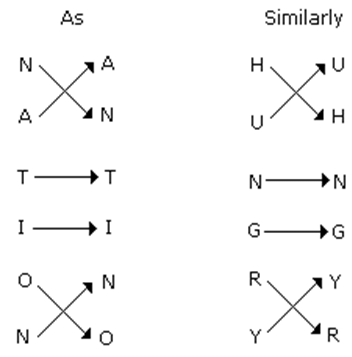
Science Section
Q11: The two main hydrocarbons present in LPG are :
(a) Butane and propane
(b) Butane and isobutene
(c) Propane and ethane
(d) Methane and ethane
 View Answer
View Answer 
Ans: (a)
Butane and propane are the two major constituents of LPG.
Q12: Select the correct statement.
(a) There must be proper supply of oxygen for combustion.
(b) Presence of combustible substance is necessary for combustion.
(c) Attainment of ignition temperature is necessary for combustion.
(d) All of the above
 View Answer
View Answer 
Ans: (d)
All the above are the conditions necessary for combustion to take place.
Q13:Fire produced by oil cannot be controlled by _________.
(a) Soil
(b) Kerosene
(c) Sand
(d) Water
 View Answer
View Answer 
Ans: (d)
Water is heavier than oil due to its relatively higher density in comparison to oil. So, on spraying water, it sinks and oil floats and the fire continues.
Q14: Read the following statement and reason and find the option which is correct?
Statement: When the copper wire is just outside of the non-luminous, it gets red hot.
Reason: The temperature of outside of the flame is low.
(a) Statement is correct, but reason is incorrect.
(b) Both statement and reason are correct.
(c) Both statement and reason are incorrect.
(d) Statement is incorrect, but reason is correct.
 View Answer
View Answer 
Ans: (a)
When the copper wire is just outside of the non-luminous, it gets red hot as the outermost zone has highest temperature.
Q15: Select the correct statement about the picture.
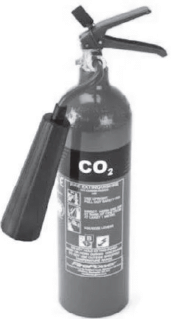
(a) Carbon dioxide produced in it cuts off the supply of oxygen by covering the fire like blanket.
(b) Water produced cuts off the supply of oxygen by covering the fire.
(c) Acid present in the container reacts with fire.
(d) Nitrogen gas produced cuts off the supply of oxygen by covering the fire.
 View Answer
View Answer 
Ans: (a)
Picture shows fire extinguisher making use of carbon dioxide. Carbon dioxide produced in it cuts off the supply of oxygen by covering the fire like blanket.
Q16: Which of the following is correct about inflammable substances?
(a) They have low ignition temperature and can catch fire easily.
(b) They have high ignition temperature and can catch fire easily.
(c) They have low ignition temperature and cannot catch fire easily.
(d) They have high ignition temperature and cannot catch fire easily.
 View Answer
View Answer 
Ans: (a)
Inflammable substances are those substances which have low ignition temperature and can catch fire easily.
Q17: The lengths of the mercury column when placed in melting ice and steam above boiling water are 9.0 cm and 44.0 cm respectively. What temperature would the thermometer indicate if the mercury column measures 23.0 cm?
(a) 10°C
(b) 25°C
(c) 40°C
(d) 65°C
 View Answer
View Answer 
Ans: (c)
- The mercury column length in melting ice is 9.0 cm, and in steam, it is 44.0 cm.
- This indicates that 9.0 cm corresponds to 0°C and 44.0 cm corresponds to 100°C.
- To find the temperature for 23.0 cm, we can use a simple linear interpolation between these two points.
- Calculating the temperature, we find that 23.0 cm corresponds to approximately 40°C.
Q18: A is a metallic plate and B is a wooden plate. A feels colder as compared to B during winters. Which of the following properties of the metallic plate causes this effect?
(a) It is a bad conductor of heat.
(b) It is a good conductor of heat.
(c) The metallic plate has a shiny surface.
(d) None of these
 View Answer
View Answer 
Ans: (b)
The metallic plate feels colder as compared to the wooden plate because the metallic plate is a good conductor of heat. When you touch steel, your skin is at body temperature while the steel is at room temperature, about 70 degrees Fahrenheit. Heat flows quickly from the warm skin to the highly conductive steel. Your skin rapidly cools off and feels cold. When you touch wood, it doesn't conduct heat very well and blocks the flow. Your skin doesn't cool off, and hence, doesn't feel cold.
Q19: The distance between two buses is 50 km, they are running in the same direction with the speeds of 40 km/h and 50 km/h, respectively. Find the time taken by one bus to cross the other.
(a) 4 hours
(b) 5 hours
(c) 2 hours
(d) 3 hours
 View Answer
View Answer 
Ans: (b)
Relative speed of two buses = 50 - 40 = 10 km/h
Distance = 50 km
Time taken to cover this distance = Distance/Speed = 50/10 = 5 hours.
Q20: What is the correct reason for making holes in big banners, meant for promotional purposes?
(a) Air takes space.
(b) Air can be compressed.
(c) Air exerts pressure.
(d) Air is affected by heat.
 View Answer
View Answer 
Ans: (c)
Air or wind, blowing at high speeds, exerts pressure on the big banners and can tear them. Therefore holes are made in them in order to allow air to pass through the banner without damaging it.
Q21: Which of the following options is/are TRUE?
(a) Algae contain chlorophyll which gives them the green colour.
(b) The main components present in carbohydrates are carbon, hydrogen and oxygen.
(c) Stomata are the tiny pores present on the surface of leaves, which help in exchange of gases.
(d) All of the above
 View Answer
View Answer 
Ans: (d)
All of the above statements are true. The main components presents in carbohydrates are carbon, hydrogen and oxygen. Stomata are the tiny pores present on the surface of leaves, which help in exchange of gases. Algae contain chlorophyll which gives them the green colour.
Q22: While performing an experiment, Riya took a burning candle and covered it with an empty glass upside down. She observed that it burns for some time and gets extinguished. What could be the reason?
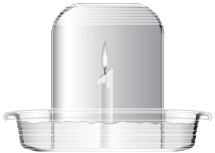
(a) The candle keeps burning for some time as long as the air present in the glass is available to it and then it goes off.
(b) The ignition temperature of the candle becomes low due to glass cover hence it goes off.
(c) The candle was burning as long as the complete wax melts away and then goes off.
(d) Oxygen is produced when the candle burns. This oxygen keeps the candle burning for some time and then it goes off.
 View Answer
View Answer 
Ans: (a)
Air is necessary for combustion. So, candle burns as long as air is there.
Q23: Which one of the following has the highest calorific value?
(a) Kerosene
(b) Biogas
(c) LPG
(d) Petrol
 View Answer
View Answer 
Ans: (c)
LPG has the highest calorific value, i.e., 55,000 kJ/kg. It means that if 1 kg of LPG is burnt completely, then it will produce 55,000 kJ of heat energy.
Q24: Neha was enjoying bursting fire crackers. Suddenly a piece of burning fire cracker fell on her clothes and it caught fire. What would be the best way to extinguish the fire here?
(a) Throw water on the clothes.
(b) Use fire extinguisher.
(c) Cover the person with a woollen blanket.
(d) Cover the person with a polythene sheet.
 View Answer
View Answer 
Ans: (c)
Cover the person with a woollen blanket so that the supply of air to the burning clothes is cut off and hence, the burning (or fire) stops.
Q25: Read the given statements and select the correct option. Statement 1: The breaking of a glass tumbler is an irreversible physical change. Statement 2: When a glass tumbler breaks, the chemical composition of glass does not change, but the pieces cannot be joined back to get the original tumbler.
(a) Both statements 1 and 2 are true, and statement 2 is the correct explanation of statement 1.
(b) Both statements 1 and 2 are true, but statement 2 is not the correct explanation of statement 1.
(c) Statement 1 is true, and statement 2 is false.
(d) Both statements 1 and 2 are false.
 View Answer
View Answer 
Ans: (a)
- Statement 1 is correct because breaking a glass tumbler cannot be reversed; once it's broken, it cannot return to its original form.
- Statement 2 is also true as the glass's chemical composition remains the same, but the physical state changes, making it impossible to reassemble the tumbler.
- Since both statements are true and the second statement explains the first, option (a) is the correct choice.
- This illustrates the concept of irreversible changes in physical processes.
Q26: Which of the following options is TRUE?
(a) Most liquids that conduct electricity are solutions of acids, bases and salts.
(b) The passage of electric current through a solution causes a chemical effect.
(c) If you pass current through a copper sulphate solution, copper gets deposited on the plate connected to the negative terminal of the battery.
(d) All of the above
 View Answer
View Answer 
Ans: (d)
- Acids, bases and salts are electrolytes and dissociate into ions in their aqueous solutions and ions are charge carriers. Hence, the solutions of electrolytes conduct electricity.
- The passage of electric current through a solution causes chemical reactions to occur.
- This is the chemical effect of electric current.
- On the passage of electric current through a copper sulphate solution, copper gets deposited on the plate connected to the negative terminal of the battery.
Hence, all the options are correct.
Q27: 'A' is a chemical substance that turns the china rose indicator dark pink in colour.
What is the colour change expected when methyl orange and phenolphthalein indicators are added to two separate samples of a solution of 'A'?
(a) The solution turns red with methyl orange and remains colourless with phenolphthalein.
(b) The solution turns yellow with methyl orange and remains colourless with phenolphthalein.
(c) The solution turns red with methyl orange and pink with phenolphthalein.
(d) The solution turns yellow with methyl orange and pink with phenolphthalein.
 View Answer
View Answer 
Ans: (a)
China rose is a natural indicator which gives dark pink (magenta) colour with acids and turns green with bases. Hence, 'A' is an acid.
Acids turn red when methyl orange indicator is added to them and remain colourless when phenolphthalein is added.
Therefore, option (a) is correct.
Q28: Directions: Analyse the two statements given below and select the correct option.
Statement I: Milk of magnesia is used as a remedy for acidity.
Statement II: Milk of magnesia is basic in nature.
(a) Both statements I and II are correct and II is the correct reason for I.
(b) Both statements I and II are correct, but II is not the correct reason for I.
(c) Statement I is correct, but statement II is incorrect.
(d) Both statements I and II are incorrect.
 View Answer
View Answer 
Ans: (a)
Milk of magnesia is Magnesium hydroxide which helps to neutralize the excess of acid secreted in the stomach. Hence it is used as a remedy for acidity.

Therefore, both statements I and II are correct and II is the correct reason for I.
Q29: X is the process of depositing a layer of zinc on iron, in order to prevent rusting.
What is the process called?
(a) Painting
(b) Electroplating
(c) Alloy formation
(d) Galvanisation
 View Answer
View Answer 
Ans: (d)
Galvanisation is the process of depositing a layer of zinc on iron to prevent rusting.
It forms a coating of zinc which, when intact, prevents corrosive substances from reaching the underlying iron.
Q30: Given below is a list of several materials. (i) Sunlight (ii) Water (iii) Cellulose (iv) Mineral (v) Chlorophyll (vi) Oxygen (vii) Carbon dioxide Which of these are necessary for a plant to produce food?
(a) (i), (iii), (v), and (vii) only
(b) (ii), (iv), (v), and (vi) only
(c) (i), (ii), (iv), (v), and (vii) only
(d) (ii), (iii), (v), and (vi) only
 View Answer
View Answer 
Ans: (c)
- Sunlight is essential for photosynthesis, the process by which plants make their food.
- Water is crucial as it helps in the chemical reactions during photosynthesis.
- Minerals provide nutrients that support plant growth, while chlorophyll is necessary for capturing sunlight.
- Carbon dioxide is taken in by plants and is a key ingredient in the food-making process.
- Thus, the correct combination includes sunlight, water, minerals, chlorophyll, and carbon dioxide.
Q31: The process X, is digestion of animal waste and production of biogas.
The process Y is the use of biogas as fuel.
Choose the correct option illustrating the processes X and Y?
(a) X is a chemical change and Y is a physical change.
(b) X is a physical change and Y is a chemical change.
(c) Both the processes involve physical changes.
(d) Both the processes involve chemical changes.
 View Answer
View Answer 
Ans: (d)
- The process X is digestion of animal waste by the action of anaerobic bacteria for the production of biogas and compost. This is a chemical change.
- The process Y is combustion of biogas as a fuel, which is also a chemical change.
Therefore, option (D) is the correct answer.
Q32: Nutrition in animals does not encompass:
(a) Nutrient requirements
(b) Mode of food intake
(c) Utilisation of digested food in the body
(d) Method of breathing
 View Answer
View Answer 
Ans: (d)
- Nutrition in animals involves various processes that help them obtain and use food.
- The options include nutrient requirements, food intake methods, and utilisation of digested food, all of which are essential aspects of nutrition.
- However, mode of oxygen intake is related to respiration, not nutrition.
- Thus, the correct answer is (d), as it does not pertain to the nutritional processes in animals.
Q33: Sohan grandmother ’s house was in a village. She used to cook on a chulha in a copper vessel. He observed that the copper vessel was getting blackened from outside. It may be due to:
(a) Proper combustion of fuel.
(b) Improper cooking of curry.
(c) Improper combustion of the fuel.
(d) Burning of copper vessel.
 View Answer
View Answer 
Ans: (c)
Copper vessel was getting blackened from outside due to incomplete combustion of fuel.
Q34: Choose the incorrect statement.
(a) Increased concentration of carbon dioxide in the air causes global warming.
(b) Increased concentration of carbon dioxide in the air causes pollution.
(c) Increased concentration of carbon dioxide in the air does not have any kind of effect on climate.
(d) Increased concentration of sulphur dioxide in the air may cause acid rain.
 View Answer
View Answer 
Ans: (c)
Increased concentration of carbon dioxide in the air does not have any kind of effect on climate.
Q35: If a piece of iron is held with a pair of tongs inside a Bunsen burner flame, which of the following would be the incorrect observation?
(a) Iron piece will become red hot.
(b) Iron piece will produce a flame.
(c) Iron piece will glow.
(d) None of the above
 View Answer
View Answer 
Ans: (b)
Iron piece will become red hot and glow. It will not produce a flame.
Q36: Read the given statements and select the correct option. Statement 1: Woollen clothes trap heat and keep us warm in cold conditions. Statement 2: Woollen fibres hold air in the spaces created between the individual fibres.
(a) Both statements 1 and 2 are true, and statement 2 is the correct explanation of statement 1.
(b) Both statements 1 and 2 are true, but statement 2 is not the correct explanation of statement 1.
(c) Statement 1 is true, but statement 2 is false.
(d) Both statements 1 and 2 are false.
 View Answer
View Answer 
Ans: (a)
- Both statements are true: Woollen clothes indeed trap heat, which helps keep us warm in cold weather.
- Explanation of statement 1: The air trapped in the pockets between woollen fibres acts as an insulator, enhancing warmth.
- Wool's properties: The structure of wool allows it to hold air, which is crucial for its insulating ability.
- Conclusion: Therefore, statement 2 correctly explains why woollen clothes provide warmth, making option (a) the right choice.
Q37: Select the incorrect statement:
(a) Coir is derived from the fruit of the kapok tree.
(b) Jute fibre is obtained from the stem of the jute plant.
(c) Linen fibre is obtained from the stem of the flax plant.
(d) Silk is a natural fibre obtained from the cocoon of silkworm.
 View Answer
View Answer 
Ans: (a)
- Coir is actually obtained from the husk of the coconut, not the kapok tree. This makes option (a) incorrect.
- Option (b) is correct as jute fibre comes from the stem of the jute plant.
- Option (c) is also correct since linen fibre is derived from the stem of the flax plant.
- Option (d) is true because silk is indeed a natural fibre sourced from the cocoon of the silkworm.
Q38: Which of the following options is not a chemical change?
(a) Digestion of food
(b) Alloying of metals
(c) Setting of curd
(d) Baking of cookies
 View Answer
View Answer 
Ans: (b)
An alloys is a homogenous mixture of two or more metals or metals with some non-metal.
Alloying is an example of a physical change.
Q39: Which of the following options shows the correct order of processes given below to make finished wool?
1. Shearing
2. Straightening, Combing and Rolling
3. Sorting
4. Dyeing
5. Scouring
(a) 1, 2, 3, 4, 5
(b) 1, 5, 3, 4, 2
(c) 1, 5, 3, 2, 4
(d) 5, 4, 3, 2, 1
 View Answer
View Answer 
Ans: (b)
- Shearing is the first step in processing fibre into wool. It is the removal of the fleece of the sheep along with a thin layer of the skin.
- The second step would be scouring, which is the process of washing the sheared hair. The woollen fibres are thoroughly washed in big tanks to remove grease, dust and dirt by fully mechanised machines.
- The third step is sorting, which is done after scouring to separate hair of different textures and types. This is to separate the low and good quality fibres.
- The fourth step is dyeing i.e., picking out of any remaining burrs (small fluffy fibres) is followed by the dyeing of fibres in various colours.
- The final steps are straightening, combing and rolling. Once the dyeing process is complete, the fibres are straightened, combed and rolled into yarn.
So, the correct option is B.
Q40: Identify the type of vitamins P, Q, and R:
P: Aids in maintaining healthy skin and enhances night vision.
Q: Contributes to the health of gums and joints.
R: Essential for blood clotting.
(a) P could be vitamin C which is found in seafood.
(b) Q could be vitamin A which is found in citrus fruits.
(c) R could be vitamin B1 which is found in yeast, egg, and liver.
(d) Deficiency of P, Q, and R could cause night blindness, scurvy, and prolonged bleeding respectively.
 View Answer
View Answer 
Ans: (d)
- Vitamin P is linked to skin health and night vision, which is often associated with Vitamin A.
- Vitamin Q relates to gum and joint health, typically connected to Vitamin C.
- Vitamin R is crucial for blood clotting, commonly attributed to Vitamin K.
- The statement in option (d) correctly identifies the deficiencies: night blindness for P, scurvy for Q, and prolonged bleeding for R.
Q41: Select the incorrect statement:
(a) Animal living in tropical rainforest can have sticky pads on its feet to climb the trees.
(b) Animal living in desert can pass out concentrated urine to conserve water.
(c) Animal living in cold regions can have a thick layer of fat under its skin to provide insulation from cold.
(d) Birds living in polar regions huddle together to keep themselves cool.
 View Answer
View Answer 
Ans: (d)
- The statement about birds in polar regions is incorrect. Birds in these areas actually huddle together to keep warm, not cool.
- Animals in tropical rainforests often have adaptations like sticky pads to help them climb trees.
- Desert animals are known to conserve water by producing concentrated urine.
- Cold region animals typically have a thick layer of fat for insulation against the cold.
Q42: Dhruvan rears silkworms to obtain silk from them. What is this process known as?
(a) Sericulture
(b) Silviculture
(c) Vermiculture
(d) Apiculture
 View Answer
View Answer 
Ans: (a)
The process of rearing silkworms to obtain silk from them is known as Sericulture. Although, there are several commercial species of silkworms. Bombyx mori (the caterpillar of the domesticated silk moth) is the most widely used and intensively studied silkworm.
Q43: Which of the following is true for saprotrophic nutrition?
(a) Organisms give away nutrients in solution form from dead and decaying matter.
(b) Organisms take in nutrients in solution form from fresh matter.
(c) Organisms take in nutrients in solution form from dead and decaying matter.
(d) Organisms take in nutrients in solution form from animals.
 View Answer
View Answer 
Ans: (c)
This mode of nutrition, in which organisms take in nutrients in solution form from dead and decaying matter, is called saprotrophic nutrition. Plants which use saprotrophic mode of nutrition are called saprotrophs.
Q44: Refer to the given Venn diagram and choose the correct option representing P.
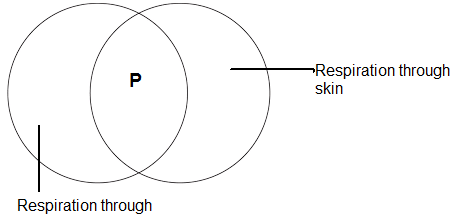
(a) Cockroach
(b) Frog
(c) Fish
(d) Earthworm
 View Answer
View Answer 
Ans: (b)
Frog can respire through both the lungs and its skin. It uses its lungs for respiration when on land. A frog can respire through the skin as well. A frog's moist skin is thin and marbled with blood vessels and capillaries close to the surface. The moisture on the skin dissolves oxygen from the air and water surrounding the frog and transmits it into the blood.
Q45: Which of the following factors affect(s) photosynthesis?
(i) Temperature
(ii) Light intensity
(iii) Oxygen
(a) Only (i)
(b) Only (i) and (ii)
(c) Only (ii) and (iii)
(d) All (i), (ii) and (iii)
 View Answer
View Answer 
Ans: (d)
All the three factors i.e., temperature, light intensity and oxygen affect photosynthesis.
Photosynthesis is the process by which green plants and some other organisms use sunlight to synthesise nutrients from carbon dioxide and water. Photosynthesis in plants generally involves the green pigment chlorophyll and generates oxygen as a by-product.
Achievers Section
Q46: Refer to the diagram given below.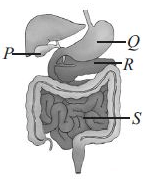
Which is the correct identification of the part that stores bile juice?
(a) S
(b) R
(c) Q
(d) P
 View Answer
View Answer 
Ans: (d)
Gall bladder is denoted by P. It temporarily stores bile juice produced by the liver.
Q47: Match the different layers of the forests (Column I) with their respective characteristics (Column II)
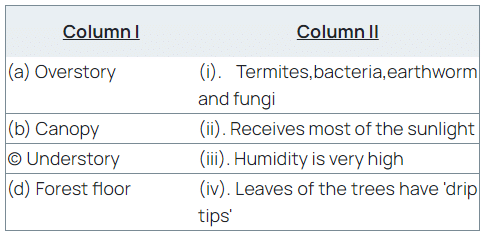
(a) a - iv, b - iii, c - ii, d - i
(b) a - i, b - ii, c - iii, d - iv
(c) a - ii, b - iv, c - iii, d - i
(d) a - iii, b - iv, c - i, d - ii
 View Answer
View Answer 
Ans: (c)
- Overstory is the top most layer in the forest that receives the maximum amount of sunlight.
- The leaves in the trees present in the canopy have drip tips for the maximum flow of water.
- The understory is the layer below the canopy. This layer has high humidity.
- The lowest layer is the forest floor, which contains humus, decaying matter and small insects.
Q48: Which of the following is/are not true?
(i) The earthworm and microbes present in the soil consume the all nutrients of the soil.
(ii) The growth of plants depends on the top layer of the soil.
(iii) Turning the soil helps to the roots to penetrate deep into the soil.
(iv) The hollow seeds are those that sink in the water.
(a) (i) and (iv)
(b) (ii) and (iii)
(c) (iii) and (iv)
(d) (i) and (ii)
 View Answer
View Answer 
Ans: (a)
Earthworms are known to be friend of a soil as it fixes all the nutrients in the soil. The hollow shape seeds are those that floats on water.
Q49: Based on the given flowchart, identify X, Y and Z.
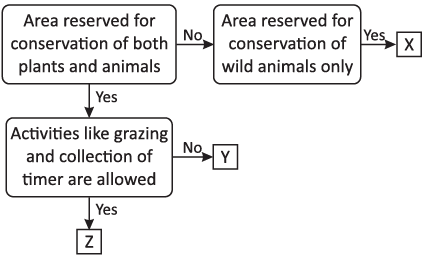
(a) X - Biosphere reserve, Y - Sanctuary, Z - National park
(b) X - Biosphere reserve, Y - National park, Z - Sanctuary
(c) X - Sanctuary, Y - National park, Z - Biosphere reserve
(d) X - National park, Y - Biosphere reserve, Z - Sanctuary
 View Answer
View Answer 
Ans: (c)
Wild sanctuary (X) is the area reserved for conservation of wild animals only, National park (Y) is the area reserved for conservation of both plants and animals. In this area, activities like grazing, and collection of timber are strictly prohibited. Z is biosphere reserve, which is also reserved for conservation of both plants and animals. In these areas, conservation of plants, animals and microorganisms are done along with traditional life forms, living in that area.
Q50: Read the given paragraph where few words are italicised and select the correct statement regarding them.
"Penguin's body is white in the front and black on the back. This helps them to mimic. They have short and thick feathers to protect them from cold. They have almond-shaped glands above eyes that help to filter out excess salt."
(a) Both white and black must be interchanged.
(b) Mimic must be changed to camouflage.
(c) Short and thick must be changed to long and thin respectively.
(d) Eyes must be replaced with ears.
 View Answer
View Answer 
Ans: (b)
- Correct statement: The word "mimic" should be replaced with "camouflage" because it better describes how penguins blend into their environment.
- Key features: Penguins have a unique color pattern that aids in their survival by making them less visible to predators.
- Feathers: Their short and thick feathers are essential for insulation against the cold, and the glands above their eyes help manage salt intake.
- Understanding: The term "camouflage" is more accurate in this context than "mimic," which implies imitation rather than blending in.
|
50 videos|125 docs|45 tests
|
FAQs on Science Olympiad Model Test Paper - 3 - Science Olympiad Class 7
| 1. What topics are typically covered in the Science Olympiad Model Test Paper for Class 7? |  |
| 2. How can I prepare effectively for the Science Olympiad Model Test Paper? |  |
| 3. What is the format of the Science Olympiad Model Test Paper for Class 7? |  |
| 4. Are there any specific books recommended for the Science Olympiad preparation for Class 7? |  |
| 5. What strategies can help in solving logical reasoning questions in the Science Olympiad? |  |
















